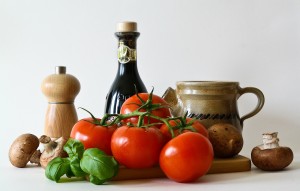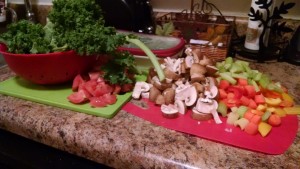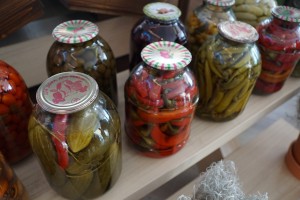The Dietary Guidelines for Americans 2015-2020 offers new recommendations focused on overall eating patterns. How can we put these Guidelines to use in everyday life? This post will be the first in a series, explaining the Guidelines’ Key Recommendations and how to apply them.
The Key Recommendations offer pointers on what a healthy eating pattern should include and limit. Let’s start by taking a look at two key food groups that we should actively work to include in our diets: Veggies & Fruits.
The average adult’s 2,000 calorie diet should include eating 2 1/2 “cup-equivalents” of vegetables per day. Some foods are more dense or airy, making a cup of each unequal in nutritional value: a cup of carrots would not offer the same nutrition as a cup of spinach. “Cup-equivalents” explains how many vegetables we need to consume a cup’s worth of nutritional value. (You need 2 cups of raw spinach and one cup of raw carrots to eat a cup-equivale nt of veggies.) For a table of vegetable cup equivalents visit MyPlate.gov.
nt of veggies.) For a table of vegetable cup equivalents visit MyPlate.gov.
The Guidelines emphasize eating a wide variety of vegetables from 5 different subgroups: dark green, red & orange, beans & peas, starchy, and other. A wide variety is important because vegetables from different subgroups provide different nutrients.
Likewise, an adult consuming 2,000 calories should: Eat 2 cup-equivalents of fruit per day. Normally, 1 cup of fruit pieces, 1 whole fruit, or 1 cup 100% juice will count as 1 cup equivalents. The guidelines emphasize eating whole fruits to aid fiber intake and limiting 100% juice intake.
juice intake.
The Guidelines emphasize making a variety of veggies and fruits a part of daily food habits. Here are steps you can take to add recommended veggies and fruits into your diet:
- Make half your plate veggies & fruits:
- The veggies and fruits fill you up and replace other less nutrient-dense foods.
- Choose multiple veggies from different subgroups for variety.
- Add veggies and fruits to your usual recipes:
- There are many recipes which are super easy to add veggies to:
- I like… mixing kale into spaghetti sauce, adding carrots and celery to my crock-pot dinner, mixing vegetables on-hand into scrambled eggs, loading soup with veggies, and placing onions, tomatoes, peppers, and romaine lettuce on burgers.
- Fruits are also easy to add to breakfast, dessert, and snack foods:
- There are many recipes which are super easy to add veggies to:
- Pack fruit and veggies(PDF) with your lunches:
- Whole fruits and veggies are easy to transport, which can make packed lunch simple to prepare.
- I like to wash a batch of produce at the beginning of each week and then just grab-n-go!
- Prepare your fruits & veggies in different ways(PDF): Bake, saute, steam, freeze, cut-up, mix in a salad, microwave… Possibilities are endless and keep you from getting bored.
- Don’t be afraid to buy canned and frozen veggies!
- Research shows the nutritional values of fruits and veggies in canned, frozen, and raw forms are similar.
- Keep your she
 lves and freezer stocked with produce for quick use when busy.
lves and freezer stocked with produce for quick use when busy. - Purchase “low-salt” or “no salt added” canned options.
Meeting the recommendations for fruits and veggies can be easy and hassle-free; it’s all about making them part of daily eating habits.
Visit http://www.whatscooking.fns.usda.gov/ for recipes that can help you achieve the Guideline’s Key Recommendations.


